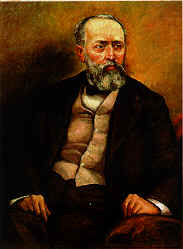
Eugeniu Carada
Founder of the NBR
The National Bank of Romania was established on 17/29 April 1880 as a result of the Romanian liberal way of thinking centred on the idea of putting in place a solid credit system. The then Minister of Finance, Ion Campineanu, became the first governor, Eugeniu Carada-the true founder-together with Emil Costinescu were responsible for the organisation and functioning of the Mint, while Theodor Stefanescu was in charge of the accounting organisation of the Bank.
The start-up capital amounted to lei 30 million, of which lei 10 million was state owned. The NBR was first improperly accommodated in a small space on the premises of The Rural Land Credit Bank. As of 16th December, the state withdrew from the association with the NBR, which turned into a privileged privately-owned bank, and the government's rights passed on to the shareholders. The Bank was granted the prerogative to issue currency by 31st December 1920, subsequently extended to 31st December 1930.
Because of the war, the NBR moved to Jassy on 15th November 1916. The German military administration seized the Bank's head office and assets in Bucharest. On 14th November 1916, the NBR Treasury was moved to Jassy then sent to Russia under the protection and guarantees offered by the Russian Government.
The Romanian Government, the National Bank, as well as other central institutions moved back to Bucharest on 1st December 1918. In those hard times, the National Bank of Romania was the only support the state could use to restore the war-torn economy and unify the circulation of money.
The NBR undertook a reorganisation after 1924. A law enacted in 1925 extended the Bank's prerogative of issuing currency for another thirty years and provided for a capital increase, from lei 30 million to lei 100 million. Moreover, the state rejoined the shareholding structure.
During the Great Depression in 1929-1933, the NBR granted loans in an effort to balance the government budget; this operation continued into the next years. The Bank's powers and role in the field of finance had been steadily growing to such an extent that it was empowered to control the banking activity, the circulation of foreign exchange, and to map out the country's financial and monetary policies.
After the communist regime seized power (6th March 1945), the banks came under state ownership in two stages: first, Communist Party members forced their way into the NBR Board on 28th November and second, banks and credit institutions were dissolved and wound up, except for the NBR and the CEC (The Savings House), on 11th August 1948.
In 1990, the National Bank of Romania has embarked upon the bumpy path of resuming the operations it had performed before 1946.